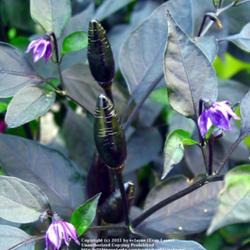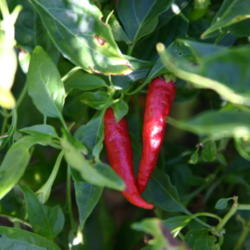I swear I didn't know it was moonshine. In the depths of winter when I was very young and when medical treatment was miles away and snow covered the ground, I only knew I couldn't breathe and bronchitis was all over me. They gave me the clear drink of hot pepper and only then could I breathe deeply and sleep again.
Of course there were different drinks for different things. Sometimes it was a sweet brownish drink flavored with lemon and honey that eased my sore throat and sent me to dreamland (a drop or two of whiskey, no doubt). But mostly, when I sounded like a baby seal with my hoarse bark, or when my chest was so tight I couldn't cough at all and my efforts to breathe were loud enough to wake long dead ancestors, I got the clear drink tasting vaguely of lemon and full of hot pepper. Cayenne. It worked quickly, every time.
It was years before I knew the spoonful of clear liquid was a mix of lemon juice and moonshine with a little water. I don't tell that secret to very many people and I never asked where the 'shine came from. But that drink, harsh as it was, accomplished miracles. I know now that cayenne in plain water would have eased the congestion just as well but instead of helping me sleep, it would have more than likely had me climbing the nearest wall and wailing as I did. The cayenne was that hot.
It was during WWII when this happened, no cars, no men, few doctors and with hospitals miles away, the ladies in my life made do with whatever they had, knowing all the time that the magic was in the plants that created the 'medicine' they gave me. The liquid that held the herbs and spices would give me healing rest, nothing more. Quite possibly it gave them much needed rest from me, too. They simply used what was available to them.

|
Let's find the magic in cayenne pepper, Capsicum annuum, although throughout the article references will be made to other capsicum varieties as well. Generally the differences are only in their heat strength, not in their nutritional value, which remains the same.
Its history:
* Cayenne peppers as well as other chili peppers can trace their several thousand year history to Central and South America. Today those regions are well known for their hot and spicy cuisines. Early they were cultivated possibly as a decorative or ritualistic item and then later as food and medicine.
* The capsicums are the oldest known spices coming from Mexico. From seeds found on the floors of caves that were likely ancient human dwellings, scientists have found that the ancients were eating hot peppers all those years ago.
* When it reached the newer worlds the Jesuit Acosta (an orator in the 1500s) wrote that it was a valuable item for trade in those areas where chili peppers did not grow. He also noted that it 'comforted the stomach' when taken in moderation and that some of the Indians used it in offerings to their gods. By this time its trade and medicinal values were noted.
* In South America, the warriors would burn peppers and use the smoke against the invading Spanish.
* During the Vietnam War, Buddhist monks armed themselves with spray guns filled with a mix of curry powder, lemon juice and cayenne.
* In India peppers have always been an indispensable part of curry.
* I find this fact to be amazing: The Hunzas in Asia Minor use cayenne as one of their main foods. They live to over a hundred years of age and have been known to play polo at the age of 150. Generally they die from falls or accidents, not from diseases.
* Cayenne pepper is the name for the hottest form of capsicum. If its heat is 1 BTU, it's called paprika; if it is from 1 - 25 BTU, it's called red pepper, but if it is over 25 BTU, then it's named cayenne.
* One of the varieties grown in the US is tabasco. The sauce was created in the mid 1800s by a banker named McIlhenny, who grew plants from the seeds in Louisiana. He made a sauce from the peppers. He left during the Civil War and when he returned, his plants were still growing and he decided to market his sauce, since the war had left him with no income. I'd say it was a surprisingly successful venture since most kitchens today contain tabasco sauce.
* For clarification purposes, tabasco is the dried ripened fruit pod of Capsicum frutescens, a very pungent pepper.

|
* This food is very low in cholesterol and sodium. It is also a good source of iron, magnesium and potassium, dietary fiber, vitamins A, C, E, K, and vitamin B6.
* Cayenne pepper is an herb made from the dried pods of chili peppers.
* Cayenne is a healing aid for the digestive system since it acts as a catalyst and increases the effectiveness of other foods and herbs when used with them.
* It is also very healing for the heart and circulatory system.
* Studies have shown that cayenne can rebuild the tissue in the stomach, which means that instead of causing ulcers, as some say, it actually helps in the healing of them. Ulcers are generally caused by stress and/or bacteria in the stomach, but not by foods.
* Cayenne is traditionally used by herbalists to cure stomach aches, cramping, gas, varicose veins, allergies, and constipation. One of the most amazing healing properties of cayenne is that it has been used successfully time after time to relieve heart attacks.
* Cayenne equalizes blood pressure, meaning it influences the heart quickly, and then just as quickly extends its effects to the blood. It also cuts mucus that is in the venous system just as it does in airways.
* Cayenne stops bleeding and when sprinkled or placed directly on an open wound, bleeding stops nearly instantly.
* It's effective externally as a liniment and is high content in some commercial ointments, particularly those sold by Watkins.
* It is also a stimulant, without any bad after affects. Combined with lobelia, it works well in cases of depression.
* Mixed with ginger, perhaps in a tea or other drink (forget the moonshine!), it does a great job of cleaning out the bronchial tubes, sinus cavities and any other congestion you might have.
In the kitchen:
* Cayenne pepper adds heat to seasoning blends, meats, pickles, seafood, Italian, Indian, Mexican and Caribbean cuisines.
* Red pepper is used in seasoned salt and chili powder.
* It heats up sauteed vegetables.
* Some add a tiny bit of cayenne to hot cocoa just for the zing it brings to the drink.
* A lot of people add it to canned beans for extra flavor.
* And when cooking bitter greens like kale or collards, add a bit of lemon juice and a sprinkle of cayenne. Nice.
Growing hot peppers:
* Hot peppers need about the same care as regular green peppers or tomatoes, but they are more vulnerable to cold. They need to be grown in soil that will not dry out quickly and is supplied with plenty of organic matter. Take care about too much nitrogen; this will cause the plants to form a lot of foliage at the expense of the fruits. You might want to fertilize at a minimum and if you know your soil is strong with organic matter, then skip the fertilizing, it isn't really necessary.
* Hot peppers must have full sun all the time, and if the temperatures are too hot, they should be kept in a greenhouse where the temps can be better controlled. The constant temperature of soil (best at about 65F) is most important and sometimes mulching helps. I know from experience that even my green pepper plants produced very little during the extreme heat and drought of this past summer, though I tried heavy mulch up to the foliage growth of the plants. Watering didn't cool them down enough either. They grew, but they didn't produce.
* It's best to grow peppers from seeds; they should be planted about 18 inches apart in rows that are about 2 feet apart.
* Peppers will bear throughout the summer as long as the fruits are picked regularly as soon as they're large enough. Fruits that haven't been picked and are hanging on the plant when frost threatens should be cut off and stored in a cool but frost-free cellar or similar place. Under such conditions they’ll keep for 3 or more months.
Preserving:
* I like to dry cayenne peppers by stringing them together. It's simple to do: using a needle threaded with coarse thread, start by poking the needle through the pepper's center and pulling the thread through until there's just enough left of the end to tie around the first pepper. Continue stringing peppers leaving an inch or two between each one. Then when finished, hang the string of peppers in a cool, dry and well ventilated area. After about 6 weeks they are ready to eat. Just leave them on the string and pinch off a pepper as you need it. A little hot pepper goes a long way.
* Just saying, but you might need to wear latex gloves when stringing.
*There are other ways to preserve, and you might enjoy reading about them right here.
And now you know. Spices come from plants and they bring with them the magic their plants contain. It's really important that they be organically grown; additives while growing could alter the magic of the plant and its spice.
And just my opinion, but I think you can leave out the moonshine part; cayenne's magic without it.
~*~
The list of peppers is mind boggling but you can find them here in our ATP database. You can also click on each image and be taken straight to the database where you'll find more descriptions of each variety of capsicum that is featured here.
Photos are courtesy of dave, eclayne, BookerC1, Paul2032 and farmerdill.
The childhood secrets that I share with you are simply to entertain; in no way should you try them without proper medical advice. Learning from different cultures is a good way to enrich our lives.
| Thread Title | Last Reply | Replies |
|---|---|---|
| Another wonderful article by mom2goldens | Apr 17, 2013 8:08 PM | 109 |